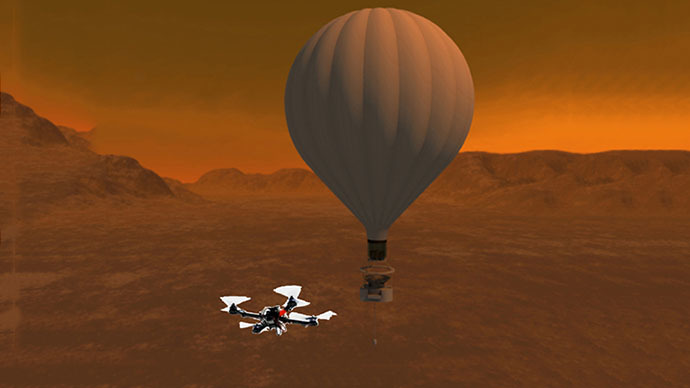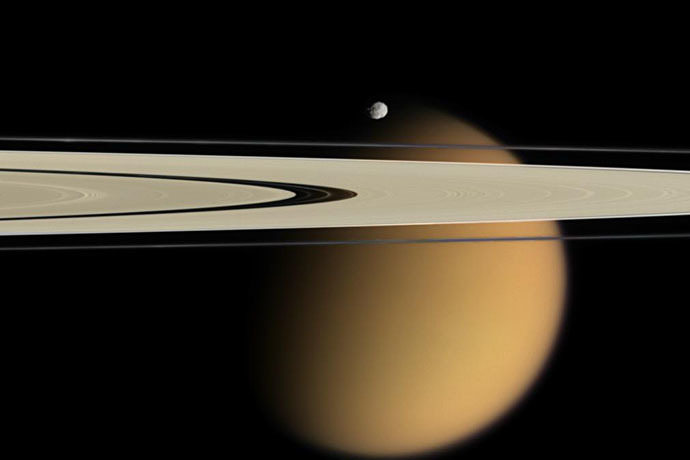NASA considers sending quadcopter drone to look for life on Titan

While one NASA probe whizzes by Saturn’s moon Titan on Thursday to analyze its atmosphere, the American space agency is also considering a plan to send a quadcopter drone capable of searching for life.
The ambitious idea was outlined by Larry Matthies, a research scientist and supervisor at NASA’s Jet Propulsion Lab in California, and involves a drone that would be capable of flying out of a lander or balloon. The drone would explore the moon’s landscape and seas, collect samples, and return to the “mothership” in order to recharge its batteries and submit whatever it collects for analysis.
If successful, the new plan could drastically change the way humans explore space. Current rovers on Mars are akin to moving laboratories, but their grounded nature means they can be rather limited when it comes to exploring terrain. The 22-pound drone conceived by Matthies would eliminate that barrier with flight capability, allegedly at much lower costs than other options.
As quoted by Gizmodo, he described the plan as follows:
“We propose a mission study of a small (< 10 kg) rotorcraft that can deploy from a balloon or lander to acquire close-up, high resolution imagery and mapping data of the surface, land at multiple locations to acquire microscopic imagery and samples of solid and liquid material, return the samples to the mothership for analysis, and recharge from an RTG on the mothership to enable multiple sorties.”

Matthies also noted that while this kind of plan would not have been feasible even just a few years ago, advancements in drone technology and other robotics have “revolutionized” older mission concepts, meaning sending a drone capable of exploring Titan is now a real possibility. Options are also available regarding exactly what form the mission takes. NASA could either have the drone operate out of an airborne balloon-like mothership or out of a land-based vehicle.
“For a lander mission, it enables detailed studies of a large area around the lander, providing context for the micro-images and samples; with precision landing near a lake, it potentially enables sampling solid and liquid material from one lander,” he said.

“For a balloon mission, it enables surface investigation and sampling with global reach without requiring a separate lander or that the balloon be brought to the surface, which has potential for major cost savings and risk reduction.”
According to the Huffington Post, NASA has awarded Matthies’ team $100,000 to continue working on designs for the unmanned concept, which includes a mothership outfitted with a nuclear reactor.
Still, any lift-off dates are still a long ways into the future. Although technology has gotten to the point where such a plan can be planned, it still needs to be developed further. The agency is hoping a launch sometime in the 2040s would be possible.
Meanwhile, NASA’s Cassini probe is scheduled to fly by Titan on Thursday and bounce radio signals off its surface for the second time in two months. The mission is intended to reveal more information about the moon’s atmosphere and lakes, which could come in handy for future missions and determining whether life could exist in its hydrocarbon seas.
"We held our breath as Cassini turned to beam its radio signals at the lakes," Cassini radio science team member Essam Marouf said, referring to the May mission, according to Space.com. "We knew we were getting good quality data when we saw clear echoes from Titan's surface. It was thrilling.”
Although Titan’s landscape presents one of the more intriguing potential habitats for life in our solar system, there are plenty of reasons to be skeptical. The moon’s seas are comprised of liquid ethane or methane, while the atmosphere is much colder than Earth’s and made up of hydrogen cyanide. Cassini has, however, revealed the possibility that liquid water may exist under the moon's icy shell, and there's speculation other forms of life could be present.














